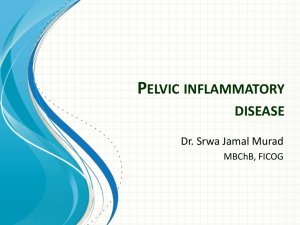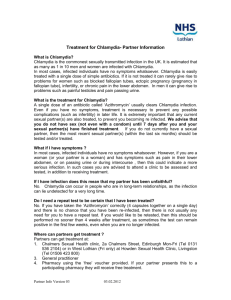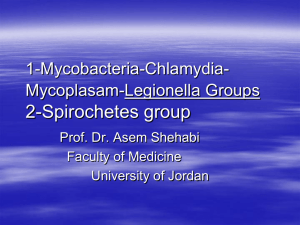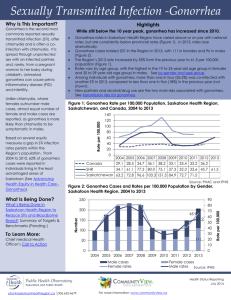Upper genital tract infection
advertisement
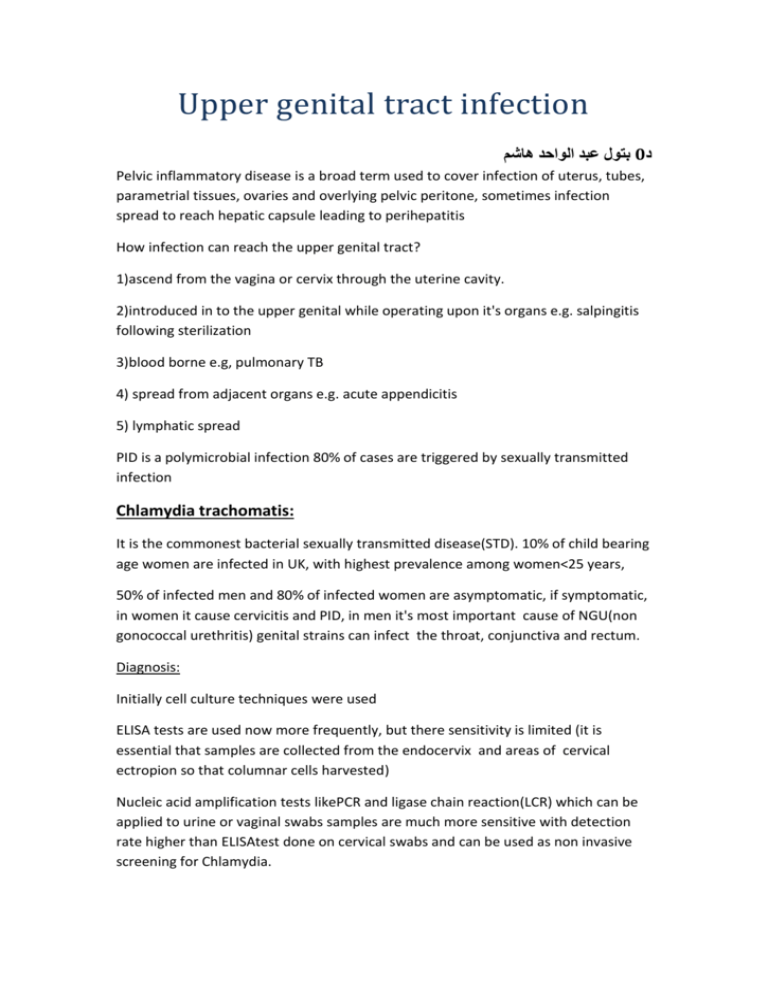
Upper genital tract infection بتول عبد الواحد هاشم0د Pelvic inflammatory disease is a broad term used to cover infection of uterus, tubes, parametrial tissues, ovaries and overlying pelvic peritone, sometimes infection spread to reach hepatic capsule leading to perihepatitis How infection can reach the upper genital tract? 1)ascend from the vagina or cervix through the uterine cavity. 2)introduced in to the upper genital while operating upon it's organs e.g. salpingitis following sterilization 3)blood borne e.g, pulmonary TB 4) spread from adjacent organs e.g. acute appendicitis 5) lymphatic spread PID is a polymicrobial infection 80% of cases are triggered by sexually transmitted infection Chlamydia trachomatis: It is the commonest bacterial sexually transmitted disease(STD). 10% of child bearing age women are infected in UK, with highest prevalence among women<25 years, 50% of infected men and 80% of infected women are asymptomatic, if symptomatic, in women it cause cervicitis and PID, in men it's most important cause of NGU(non gonococcal urethritis) genital strains can infect the throat, conjunctiva and rectum. Diagnosis: Initially cell culture techniques were used ELISA tests are used now more frequently, but there sensitivity is limited (it is essential that samples are collected from the endocervix and areas of cervical ectropion so that columnar cells harvested) Nucleic acid amplification tests likePCR and ligase chain reaction(LCR) which can be applied to urine or vaginal swabs samples are much more sensitive with detection rate higher than ELISAtest done on cervical swabs and can be used as non invasive screening for Chlamydia. Direct fluorescent antibody test(DFA) done on cervical smear and is more appropriate than ELISAwhen both are done on rectal or conjunctival swabs Serological tests are not performed routinely in the diagnosis of Chlamydia infections, micro immunoflourescence can be used to detect serum antibodies which are not present in all infected individual. highest antibody titre are found in women with PID or disseminated infection, and 60% of women with tubal factor infertility. It's essential that sex partners are screened fully for STI and treated for Chlamydia before sexual intercourse is resumed. The following treatment are effective for uncomplicated Chlamydia infection Doxycycline 100mg twice/day for 7 days, azithromycin 1gm single dose,ofloxacine 400 mgfor 7 days, in pregnancy,azithromycin1 gm single dose, erythromycin500 mg twice/D for 14 days Gonorrhoea: Gram negative diplococcic, colonize columnar or cuboidal epithelium, protective immunity does not appeare to develop, there are no reliable serological test for N. gonorrhea, resistant strain emerge rapidly. High level resistance to penicillin is mediated by plasmid. Resisitance to quinolone antibiotic have emerged in developing countries in the last 2 decades. Prevelance, is less than 1% in women of child bearing age, chronic asymptomatic infection is common, 50% of infected women are asymptomatic, 70% of infected men are symptomatic, it cause urethritis, tonsillitis, conjunctivitis, and proctitis. Diagnosis Gram –staied smear of urethral, cervical and rectal swabs, it is fastidious M.O., requiring 7%co2 concentration, blood agar, antibiotic to inhibit the growth of other organisms. It may fail to grow on culture if transport to the lab. Was delayed, but culture is necessary for antibiotic sensitivity. DNAbased detection are available for screening. Sex partners are screened fully for STIs and treated for gonorrhea before sexual intercourse resumed,50% of women treated for gonorrhea have concomitant Chlamydia infection and Chlamydia treatment should always be prescribed for gonorrhea patients and their partners. Women should have 2 sets of culture performed following treatment as test of cure. The following treatment are effectiveagainst sensitive strains of gonorrhea Amoxycillin1g+probencid2g as single dose Ciprofloxacine500mg as a single dose Spectinomycin2 g as a single doseIM Azithromycin 1g single dose Ceftriaxone250mg single dose Cefixim400mg single dose Mycoplasma genitalium is propably STI implicated in PID in women and in NGUin it's difficult to detect, require especial culture medium or PCR test. Endogenous anaerobes, such as Bacteroides spp. Or mycoplasma hominis, often come in as secondary invaders and are responsible for subsequent tubal abscess formation. Cervicitis: Mucopurulent cervicitis is a clinical diagnosis based on detecting purulent mucus at the cervical os and is often accompanied by contact bleeding. It can be confused with a benign ectropion, but the latter does not usually bleed heavily unless swabbed very vigorously. Presentation is either with postcoital bleeding or complain of purulent vaginal discharge , however it can be asymptomatic. Aetiology often caused by STIs with male partner having NGU Diagnosis tests for Chlamydia and gonorrhea should be performed. if ulceration is present test for herpes simplex. Nabothian follicles are mucus containing cyst up to 1 cm in diameter, which are often present following chronic cervicitis which cause scarring. Pelvic inflammatory disease: Infection ascends into the uterus, Fallopian tubes, ovaries, and parametrial tissues. Clinical features: Essential features Pelvic pain, usually bilateral. cervical excitation adnexal tenderness on digital pelvic exam. Supporting features: Intermenstrual/ abnormal bleeding or postcoital bleeding(endomeritis, cervicitis) Increased/ abnormal vaginal discharge Deep dyspareunia Vaginal discharge Fever Nausea vomiting Right upper abdominal pain/tenderness Generalized peritonitis Differential diagnosis: 1-ectopic pregnancy 2-ovarian accident 3-acute appendicitis 4-irritable bowel syndrome 5-inflammatory bowel disease 6-UTI 7-bowel tortion 8-psychosomatic pain Investigations: Blood tests: (WBC,ESR, CRP-non specific-, pregnancy test-to exclude ectopic pregnancy-) Microbiological tests—endocervical swab for gonorrhea culture ---endocervical swab for chlamydiaNAAT --Microscopy for cervical pus cell If positive or patient at high risk for STI----offer microscopy /culture for T.vaginalis ------HIV ab test ---syphilis serology Radiological investigations: TVS(free fluid, exclude other diagnosis, detect tuboovarian abscess) Power Doppler MRI, CTscan , kept for cases with doubtful diagnosis. Surgical diagnosis: definitive diagnostic procedure is laparoscopy, as an invasive procedure it should be kept to cases with doubtful diagnosis Or patient fail to respond to antibiotic within48-72hrs. Treatment: most patients are treated as outpatient, the antibiotic should cover Chlamydia, gonorrhea, and anerobes Ceftriaxon 250mg im+doxycycline 100mgbd(14 days)+metronidazole 400 mg bd(5 days) or ofloxacine 400 bd(14 days)+metronidazole 400mg(5 days) Inpatient care indicated if: Patient is systemically unwell Severe symptoms such as acute abdomen Tubal abscess is suspected And those should be treated with IV antibiotics initially iv cephalosporines+metronidazole,2-3 days, then followed by oral doxycycline(14 days) +metronidazole e.g.cefxitin 2g QID+iv or oral doxycycline 100 mgBD followed by oral doxycycline+ metronidazole(BD) It's essential that sexual partner is screened for STI and treated. Surgery is indicated To drain pelvic abscess If doubtful diagnosis Ultrasound guided aspiration is less invasive as effective as laparoscopy or laparotomy. Other complications of Chlamydia and gonorrhea Periappendicitis and perihepatitis(Fitz-Hugh-Curtis syndrome) Reiter's syndrome(sexually acquired reactive arthritis) Septic oligoarthritis(disseminated gonorrhea infection) Sequels of PID: Recurrent PID Ectopic pregnancy Tubal factor infertility Chronic pelvic pain Female genital tract tuberculosis:FGTTB Exact incidence is not accurately known-underreportedVaries from1% in USto 1-19% in various parts of india FGTTB is almost always secondary to pulmonary(commonest) or extrapulmonary TB Primary FGTTB in women who are partners of males had active genitor urinary TB through infected semen Fallopian tubes involvment100% Endometrial TB50-80% Ovarian TB is rare and often seen as part of TB peritonitis Cervical TB5-15% Vagina &vulva 1-2% TB &infertility: Infertility is the commonest presentation of FGTTB both primary and secondary infertility may occur. The reasons for infertility are: Blocked damaged tubes, non receptive and damaged endometrium with Asherman's syndrome, and ovarian damage. Clinical presentation(symptoms and signs): Systemic manifestations; fever, LAP, crackles on chest exam Abdominal exam;mass,ascites Vaginal exam;uterine enlargement(pyometra), adnexal tenderness, adnexal masses, tubo-ovarian mass, fullness and tenderness in POD Unusual signs;hypertrophic or ulcerative lesions in cervix, vagina or vulva Gynecological fistulae. Investigations CBC, ESR CXR Mantoux-tuberculin test Serology(HIV) Endometrial biopsy, curettage or aspirate(in the premenstrual phase);for histopathological testing for granuloma, specimen forAFBsmear and culture, PCR Mycobacterial smear and Lowenstein-Jensen media culture of secretions from vagina, cervix, peritoneal fluid or tubal biopsy,PCR Imaging methods US,CT, MRI,PET Blood markers in genital TB, CA125(usually, the level in GTTBis only mildly elevated<200 but could be very high in disseminted TB Hysterosalpingography;is contraindicated in known cases of GTTB , but usually diagnose GTTB retrospectively while investigating women for infertility Hysteroscopy Laparoscopy, macroscopically the tubes are thickened, with fibrosis and peritubular adhesions, the fimberia remain everted retort-shape tube, the tubes are patent but functionless.Yellow pus with caseations. Treatment 9 monthsregimen Rifampicin450-600 mg Isoniazide300/day Ethanbutol 15mg/kg/day(in the 1st 2 months only with prophylactic pyridoxine 6 months regimen Rifampicin450-600 mg Isoniazide300mg/day Ethanbutol15mg/kg/day in the 1st 2 months only Pyrazinamide(20-30 mg /kg/ day in the 1st 2 months only, with prophylactic pyridoxine Repeat endometrial sampling, negative bacteriological exam twice 6 mo apart with 2 negative reports mean cure.
